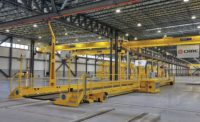CRRC MA
Springfield, Mass.
Best Project
Owner: CRRC MA Corp.
Lead Design Firm: Gannett Fleming Engineers & Architects Inc.
Construction Manager/Design Build: Plaza Construction LLC
Civil Engineer: VHB
Structural Engineer: Gannett Fleming Engineers & Architects Inc.
MEP Engineer: Robt. W. Hall Consulting Engineers Inc.
Geotechnical Engineer: O’Reilly, Talbot & Okun
Landscape Architect: Greylock Design Associates Inc.
This project, which involved the construction of a rail car assembly facility, was delivered one month early and 8% under budget despite schedule constraints and the discovery of unsuitable soil. The fast-track, design-build project brought manufacturing jobs back to Springfield for the first time in decades. As one judge said: “The fact they set up shop out there and are now producing rail cars for entities across the country, goes above and beyond.”
The 18-month project was the first North American rail car manufacturing facility constructed by the Chinese owner CRRC, the world’s largest railway transportation equipment and service provider. The facility will manufacture next-generation rail cars for the MBTA Red and Orange subway lines. The project included the development of a 40-acre brownfield site, installation of infrastructure for both the project and potential future expansion, renovation of an existing three-story, 36,000-sq-ft office building and construction of a 4,400-ft rail car storage track and construction of a 2,240-linear-ft electrified test track.
The team also incorporated owner-supplied assembly equipment into the facility. For operation of the test track and testing and commissioning of the completed rail cars, the team also designed and installed six overhead bridge cranes ranging from 5 tons to 25 tons and coordinated the industrial engineering for the assembly lines to assemble and test the rail cars and a 3-MW system for the operation of the outdoor test track.
As part of the project, the team says it coordinated the infrastructure and installation of several pieces of equipment, including a 100-ft traverse table for delivering rail cars to assembly stations, an 80-ft-long water test chamber for testing weather tightness of the completed cars and bogie assembly equipment for assembling rail car undercarriages.
Early in design, the team conducted geotechnical analysis and determined that the soil was comprised of non-engineered fill, which had inadequate weight-bearing capacity. The fill, varying in depth up to 15 ft, was from historic fill operations and demolition of manufacturing buildings that once occupied the site. The team consolidated the soil with rapid impact compaction (RIC). The onsite ground improvement technique helped reduce the schedule by four weeks. An estimated 6,500 locations were compacted at the site, including 225,000 sq ft beneath the new building and 97,000 sq ft along the facility’s test track. One judge said, “The intricacy of having to have live test tracks outside and the fact they had to deal with loading the soils made it a complex site that set the stage for that part of the country to be able to excel in future production.”








Post a comment to this article
Report Abusive Comment